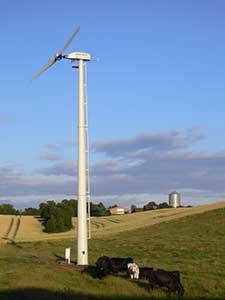
Background
Wind Speed and Usage Requirements
Site Selection Rules
Background
Small wind turbines are generally linked with a property and consequently are often not located in the 'prime wind' sites such as those sought by commercial power generators. Nevertheless, if care is taken with regard to selection of the turbine and it’s positioning on a suitable site, a small wind turbine can be an economically attractive proposition for the owner as well as making a significant contribution to greenhouse gas reduction.

Wind Speed and Usage Requirements
It is important to select a turbine to match your site wind speed and energy usage requirements. A turbine that performs well in a high wind speed site can be disappointing in a moderate wind speed site and vice versa. All turbines perform poorly at low wind speed sites or in very turbulent winds.
Site Selection Rules
The position of your turbine both in terms of its relation to local topography and the rotor height can significantly affect the performance of your turbine. The following rules of thumb apply:
- There should be no, or minimal, obstructions in the direction of the prevailing wind.
- Obstacles such as buildings and trees degrade wind quality by producing turbulent zones in their vicinity. These can significantly reduce the output of a turbine. It is important, therefore to select a tower of sufficient height to allow the rotor to sit above any potentially turbulent zones.
- Wind speed tends to increase with height in most locations, a phenomenon known as wind shear. This variation in velocity with altitude is most dramatic near the surface.
Further, the energy in the wind is proportional to the cube of the wind speed. Consequently a small change in wind speed produces a much larger change in wind energy. For example: increasing the height of a turbine rotor, from 9m to 18m will increases the expected wind speeds by 10% and the expected energy generated by 34%.
Source: Gaia-Wind